Sorry, Prof. Guth…
…but it’s been discovered by empirical observation that the universe is not, as you famously claimed, the “ultimate free lunch.” Rather, the FQxi Conference on Foundational Questions in Physics and Cosmology in Reykjavik, Iceland is the ultimate free lunch.

Speaking of which, above you can see the discoverer of cosmic inflation himself, together with theoretical physicist Lawrence Krauss on his left, chatting on a glacier only minutes after engaging in a snowball fight.
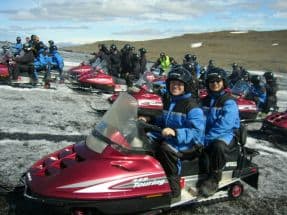
And your humble blogger, who still can’t parallel park, hoping he’ll be able to steer a snowmobile without falling into any 1000-foot crevices.

Here I am with Cosmic Variance‘s Mark Trodden (who blogged earlier about this conference, saving me a good deal of work).
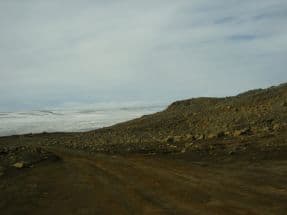
The dirt above is all area where the glacier previously was, but retreated over the last few decades.
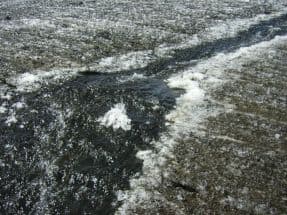
To all those who say global warming is a myth: lo, I have watched a glacier melting with mine own eyes.

The geothermally-heated lagoon where part of the conference was held.

And just in case debating unfalsifiable cosmic hypotheses in a lagoon isn’t tacky enough, a PBS crew (from a show called “Closer to Truth”) was there to film it.
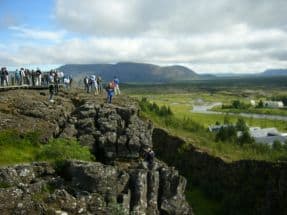
This is said to be the official divide between the North American and European tectonic plates.

In North America this would be a major tourist attraction with hotels, casinos, cotton candy shops, etc. Here it’s just another waterfall.
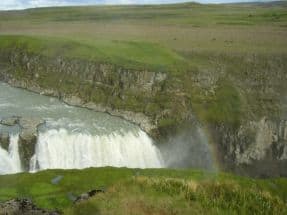
Curse me lucky charms, there’s no pot o’ gold!
 Follow
Follow
Comment #1 August 1st, 2007 at 6:11 am
FQxi Conference on Foundational Questions in Physics and Cosmology in Reykjavik, Iceland is the ultimate free lunch.
That’s because it’s funded by John Templeton, the famous billionaire philanthropist from the religious right.
Comment #2 August 1st, 2007 at 7:55 am
Right — and when I was deciding whether to accept the free trip, that fact presented me with a moral dilemma that took almost an entire minute to resolve.
Comment #3 August 1st, 2007 at 2:29 pm
Great incentive to submit to ICALP 2008!
Comment #4 August 1st, 2007 at 6:28 pm
looks beautiful.
Comment #5 August 5th, 2007 at 10:56 am
I tacked this query onto the end of the July 29 Cosmic Variance item too, repeating a question asked by a commenter “Levi” that wasn’t answered there or in Eugene Lim’s blog reports:
What was said about the problem of putting a probability measure on eternally inflating spacetimes, or on possible parameter sets in the Landscape in general? Anything later than
D. Schwartz-Perlov and A. Vilenkin:Probabilities in the Bousso-Polchinski multiverse. JCAP 0606, 010 (2006), hep-th/0601162.
—? I have a possible research reason for asking—all pointers to recent papers or commentary on the “multiverse measure problem” are welcome.
Comment #6 August 6th, 2007 at 12:36 pm
I made a submission to a thread of Not Even Wrong about that conference, which submission was considered from a few days, and then deleted, along with a comment on the comment by another professor. Since the latter lassoed in Godel, I thought that your blog might be a better venue. But that’s up to you, of course.
============
Not Even Wrong blog
“Really Quick Links” thread
http://www.math.columbia.edu/~woit/wordpress/?p=580#comment-27187
# Jonathan Vos Post Says: Your comment is awaiting moderation.
August 4th, 2007 at 1:12 am
“Reading ‘The Computational Universe’ it’s clear that to have a completely accurate model of the universe would require something with the size and energy of the Universe itself to run the model.”
What I’ve been saying since I hung out with Feynman in 1968-1973 is:
“the universe is the least-action computer that can calculate the state evolution of the universe. Larger universes can do so, and can be nested in each other, but ours is the fixed point of the simulation hierarchy.”
Feynman had suggested quantum computers to simulate quantum systems, precisely for such parsimony of simulation.
I don’t think that’s either anthropic or stringy. But does it make sense to anyone today?
============
Then Forrest Bishop opined:
“the universe is the least-action computer that can calculate the state evolution of the universe.” –JVP
I agree, and independently came to the same conclusion long ago. The “larger universe” conjecture is avidly pursued by the simulation argument proponents. It lacks parsimony, as does a “smaller universe of fewer turtles” conjecture, from the other side.
============
Finally, Prof. Phillip V. Fellman emailed to say:
Insofar as I understand it, I take this to be the
point of Godel’s incompleteness theorems. Thus, I
have been especially suspicious of any popular usage
of any concept labeled as a “theory of everything.”
Similarly, as I have previously noted, the stupidest
sentence which I have repeatedly heard coming out of
some very intelligent physicists’ mouths, often when
introducing a novel discovery (in at least some ways
ameliorating and in other ways thus compounding the
sin) is composed of words to the effect “of course
when we have a complete picture of nature…” etc.,
etc. To do this, I think, is to fall into the
fundamental trap of David Hilbert’s mathematical
agenda for the 20th century, which was, of course,
destroyed by Godel’s work in fairly short order.
Now the interesting thing which brane theory, or
perhaps I should say brane-based explanations of
cosmology offers is that just as we followed Sato’s
description of computational classes and computational
spaces relating to orders higher than conventional
p-space (NAACSOS 2004), brane-based cosmologies allow
us a more serious characterization of a “larger
universe” or a series of nested universes. In this
sense, it then becomes meaningful, to at least
contemplate, in theory, that the complete picture or
our brane’s nature could be knowable (but probably not
by us). Now I wonder does this make the whole thing
anthropic?